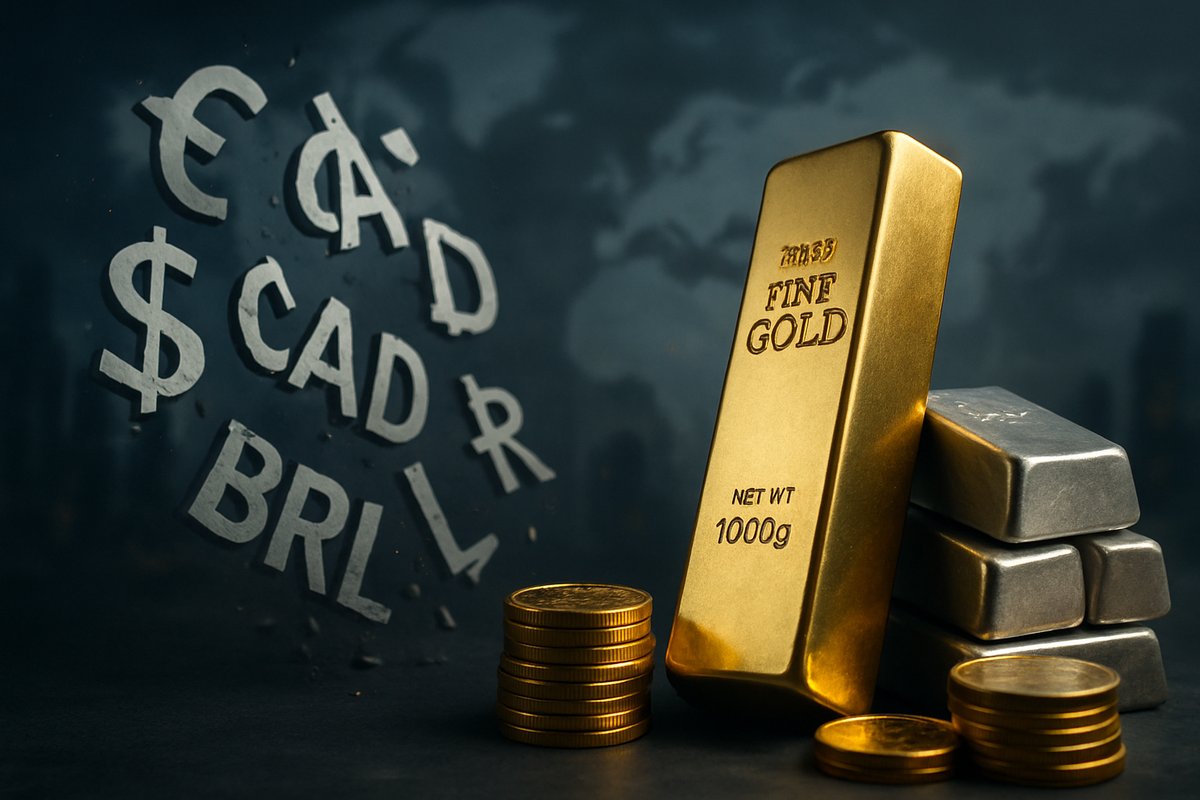
October 16, 2025, marks a pivotal moment in global financial markets, as a pervasive wave of uncertainty has sent commodity currencies into a significant decline while simultaneously propelling gold and silver to unprecedented record highs. This dramatic shift underscores a profound recalibration of investor sentiment, signaling a widespread retreat from risk-sensitive assets and a fervent flight to safety amidst an increasingly volatile global landscape.
The immediate implications are far-reaching: a 'risk-off' mentality now dominates, leading to substantial capital reallocation. Commodity-exporting nations are bracing for economic headwinds as their currencies weaken, while the surging value of precious metals reflects deep-seated anxieties over geopolitical stability, persistent inflation, and the long-term viability of traditional financial instruments. This trend indicates a fundamental re-evaluation of risk appetite and a growing distrust in traditional financial instruments and fiat currencies.
The Great Metal Rush of 2025: A Detailed Account
The financial world witnessed a dramatic divergence today, with gold prices surging past $4,000 per ounce, even briefly touching $4,078, and COMEX's gold contract (GCZ5) reaching an impressive $4,150 per ounce. This represents a staggering year-to-date return of approximately 57%. Silver, not to be outdone, broke above $50 per ounce, spiking to $51.7, with COMEX's silver contract (SIZ5) surpassing $50 per ounce for the first time since May 2011, boasting a year-to-date gain of roughly 70%. Spot silver prices reportedly surpassed the $50 mark for the first time in over four decades, rising to $51.95 an ounce.
Conversely, a broad spectrum of commodity currencies, including the New Zealand Dollar (NZD), Australian Dollar (AUD), Canadian Dollar (CAD), Brazilian Real (BRL), Colombian Peso (COP), Chilean Peso (CLP), South African Rand (ZAR), and Mexican Peso (MXN), experienced notable slumps against the US dollar. This underperformance has been a defining characteristic of financial markets through much of 2025, intensifying significantly into the latter part of the year.
This market upheaval is the culmination of months of escalating global uncertainties. Late 2024 saw the Federal Reserve initiate a pivotal shift towards monetary easing, with an initial 50-basis-point interest rate reduction in September, contributing to market uncertainty. By the second quarter of 2025, key commodity-exporting nations reported significant economic contraction, signaling weakening global demand. Throughout 2025, a sustained underperformance of commodity currencies became evident, driven by renewed global trade tensions, divergent monetary policies, and weakening domestic economic indicators. The International Monetary Fund (IMF) on October 7, 2025, highlighted how rising global uncertainty typically increases investor risk aversion, boosting demand for safe-haven assets. This set the stage for gold and silver to hit all-time highs on October 13, 14, and 15, leading directly to today's record-breaking surge.
The faltering of commodity currencies is primarily attributed to a projected decrease in global industrial activity and consumer demand, leading to lower prices for critical raw materials. This "negative demand shock" is exacerbated by ongoing geopolitical tensions and renewed global trade conflicts. The surge in gold and silver, on the other hand, is fueled by intensifying "risk-off" sentiment, monetary policy uncertainty (especially anticipated Fed rate cuts), persistent inflation fears, geopolitical instability in Eastern Europe and the Pacific, and robust central bank gold purchases. Silver's rally is further bolstered by strong industrial necessity, particularly from solar panel manufacturing, and a significant liquidity squeeze in the London market. Key players include global investors, central banks (particularly the Federal Reserve), commodity-exporting nations, and multinational corporations adapting to this volatile environment.
Companies Navigating the Storm: Winners and Losers
The current financial climate, characterized by plummeting commodity currencies and soaring precious metals, creates a distinct landscape of winners and losers among public companies.
Leading the charge among the beneficiaries are the gold and silver mining companies. These firms directly reap the rewards of higher selling prices, leading to substantial increases in revenue and expanded profit margins. This environment also incentivizes greater exploration and makes previously uneconomical deposits viable. Giants like Barrick Gold Corporation (NYSE: GOLD, TSX: ABX) and Newmont Corporation (NYSE: NEM) are seeing their valuations bolstered, while Agnico Eagle Mines (NYSE: AEM, TSX: AEM), Kinross Gold Corporation (TSX: K, NYSE: KGC), Alamos Gold (NYSE: AGI, TSX: AGI), and Harmony Gold (NYSE: HMY) are also experiencing significant gains. Precious metals streamers and royalty companies, such as Franco-Nevada Corporation (NYSE: FNV, TSX: FNV), Wheaton Precious Metals Corp. (NYSE: WPM, TSX: WPM), and Royal Gold, Inc. (NASDAQ: RGLD), also thrive as the value of their agreements tied to future production increases without bearing direct operational costs. Furthermore, gold-backed Exchange-Traded Funds (ETFs) like SPDR Gold Shares (NYSEARCA: GLD), iShares Gold Trust (NYSEARCA: IAU), and VanEck Vectors Gold Miners ETF (NYSEARCA: GDX) are seeing their asset values appreciate significantly due to massive inflows.
On the other side of the ledger are companies deeply intertwined with the faltering commodity currencies or those reliant on precious metals as industrial inputs. Businesses operating within or heavily reliant on economies tied to currencies like the Canadian Dollar or Australian Dollar face reduced demand and lower profitability. Multinational retailers and consumer goods companies with significant sales in these regions, such as Walmart (NYSE: WMT) or Coca-Cola (NYSE: KO), could see the value of their repatriated earnings diminish. Manufacturers that use gold and silver as industrial inputs, particularly in electronics and solar panels, face increased production costs. Companies like Samsung (KRX: 005930), Intel (NASDAQ: INTC), Apple (NASDAQ: AAPL), and solar panel manufacturers like First Solar (NASDAQ: FSLR) will need to manage these rising expenses. Jewelry retailers, including Signet Jewelers (NYSE: SIG) and Indian jewelers, are grappling with higher material costs which can dampen consumer demand, especially for more affordable silver items. Additionally, if the weakness in commodity currencies stems from a broader downturn in other commodity prices (e.g., oil, industrial metals), then major oil & gas companies like ExxonMobil (NYSE: XOM) or diversified miners like Rio Tinto (ASX: RIO, LSE: RIO) could also face headwinds in their non-precious metals segments.
Broader Implications: A Shift in Global Financial Tides
The confluence of faltering commodity currencies and soaring gold and silver prices on October 16, 2025, signals a profound and multifaceted shift in the global financial and economic landscape, deeply intertwined with broader industry trends and carrying significant regulatory and historical implications.
This market dynamic reflects accelerating trends towards de-dollarization and geopolitical fragmentation. The underperformance of currencies like the AUD and CAD is partly due to renewed global trade tensions and divergent monetary policies, exacerbated by a growing desire for financial autonomy, particularly among BRICS nations. This indicates a palpable lack of confidence in traditional financial instruments and fiat currencies amidst persistent inflation concerns and ballooning national debts. Furthermore, the ongoing energy transition plays a decisive role; currencies of nations reliant on traditional fossil fuel exports face persistent headwinds, while silver, in particular, benefits from its crucial industrial uses in solar panels and electronics, with demand forecast to reach record levels in 2025. The unprecedented surge in gold and silver underscores a pronounced "risk-off" sentiment, driven by deep-seated concerns over economic stability, inflation, and geopolitical uncertainty, leading investors to seek the perceived safety of hard assets.
The ripple effects are extensive. While precious metals miners and associated investment vehicles thrive, businesses in commodity-exporting nations face rising costs and squeezed margins. Industrial commodity sectors could experience reduced sales, and commodity trading firms focused on industrial goods may see reduced activity. The financial ecosystem, including brokers and exchanges, sees increased trading volume, but extreme volatility, especially in silver, necessitates enhanced risk management. Regulatory bodies and central banks are likely to reassess monetary policies and strategic reserves, with a sustained trend of central bank gold buying reinforcing its position as a strategic asset. There may also be increased scrutiny of speculative activity in precious metals. Historically, gold and silver have served as safe havens during economic uncertainty, political instability, and currency debasement, echoing patterns seen during the 2008 financial crisis, the collapse of Bretton Woods, and other periods of systemic stress. The current rally is seen as a structural repricing of gold relative to fiat benchmarks, fueled by "debasement fears" and a generally inverse relationship with the U.S. dollar, which, despite its own safe-haven appeal, is weakening against other major currencies due to anticipated rate cuts and government shutdowns.
The Path Forward: Navigating a Volatile Future
Looking ahead, the current market dynamics suggest a challenging yet potentially rewarding path for investors and businesses alike. In the short term (next 6-12 months), the bullish momentum for gold and silver is expected to continue, with some experts even forecasting gold to reach $5,000 per ounce within the next year. However, broader commodity prices, excluding precious metals, are projected to decline due to improved supplies, policy uncertainty, and a global economic slowdown. Persistent inflationary pressures will likely sustain investor interest in real assets, while market fragmentation could lead to extreme price volatility and supply chain disruptions. The silver market, in particular, may see continued backwardation, driving prices higher amidst limited physical inventory.
In the long term (beyond 12 months), structural economic shifts, notably the global energy transition, will be a decisive factor. Currencies of nations reliant on traditional fossil fuel exports may face persistent headwinds, while those linked to critical minerals for green technologies could gain long-term support. Geopolitical realignments are expected to accelerate a shift towards a more localized and resilient global economic order, with a continued push for de-dollarization and the development of alternative monetary systems by BRICS nations. Some optimistic forecasts even predict gold could reach $10,000 per ounce by 2030, driven by ongoing geopolitical tensions and concerns over fiat currency stability.
Strategic pivots are crucial for all stakeholders. Businesses must prioritize supply chain resilience through diversification and localized sourcing, implement robust hedging strategies against currency volatility, and diversify portfolios to include commodities benefiting from the green energy transition. Governments will need to continue diversifying foreign exchange reserves by increasing gold holdings, strategically invest in critical mineral processing, and adopt strong fiscal frameworks to manage revenue volatility. Investors should maintain diversified portfolios with significant allocations to safe-haven assets like gold and silver, explore thematic investments in critical minerals for the energy transition, and remain vigilant to geopolitical developments, inflation reports, central bank policies, and the strength of the U.S. dollar. Emerging market economies with dollar-denominated debt face the significant challenge of higher debt servicing costs and potential capital outflows.
A New Era of Financial Prudence
Today's market movements underscore a fundamental shift in the global financial landscape, characterized by deep-seated anxieties and a pronounced flight to safety. The faltering of commodity currencies, driven by global uncertainty and weakening demand, stands in stark contrast to the unprecedented surge in gold and silver, which have solidified their roles as premier safe-haven assets. This dynamic reflects a growing distrust in traditional financial instruments and fiat currencies, fueled by persistent inflation, geopolitical instability, and central bank monetary policy shifts.
Moving forward, the market will likely be defined by continued volatility and a clear bifurcation in asset performance. Precious metals and critical green energy commodities are poised to outperform, while traditional commodity sectors and their associated currencies may struggle amidst structural economic shifts and intensified geopolitical competition. This environment necessitates a new era of financial prudence, where adaptability, strategic foresight, and robust risk management are paramount.
Investors should closely monitor geopolitical developments, global inflation reports, central bank monetary policies (especially from the U.S. Federal Reserve), the strength of the U.S. dollar, and the supply-demand balances in key commodities. The lasting impact of this period could be the acceleration of a multipolar financial system, a heightened focus on tangible assets as hedges against systemic risk, and a re-evaluation of global supply chains for resilience over efficiency. The events of October 16, 2025, serve as a potent reminder that in times of uncertainty, the allure of gold and silver shines brightest.
This content is intended for informational purposes only and is not financial advice





